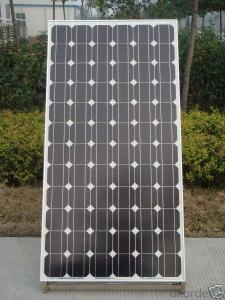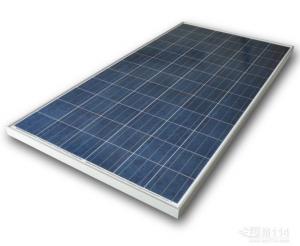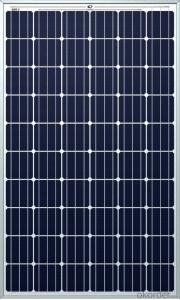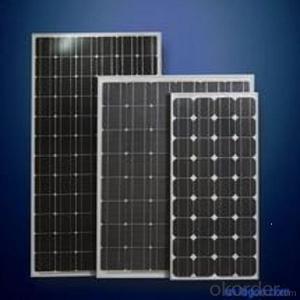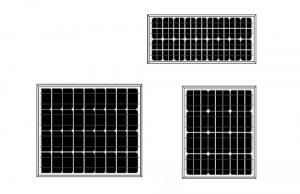Series Solar Panels - 310W Mono & Poly 260W/265W/270W/280W/300W/310W High Efficiency Solar Module
- Loading Port:
- Shanghai
- Payment Terms:
- TT OR LC
- Min Order Qty:
- 1000 watt
- Supply Capability:
- 10000 watt/month
OKorder Service Pledge
OKorder Financial Service
You Might Also Like
Specification
Features
1) Product name: solar panel / module
2) Solar cell: Mono-crystalline / Poly-crystalline / Amorphous
3) Tempered glass laminated with aluminum frame
4) Life time: 20 - 25 years
5) Temperature co-efficiency: A=+1,46mA B=-79mV, Rp/p=-0.43
6) Power specification at 1kW/m 2, AM 1, 5
7) Output cable: multi contact connectors
8) Construction:
a) Front: High-transmission 32mm tempered glass
b) Back: TPT
c) Encapsulant: EVA
9) Frame: aluminum
10) Certification: CE, TUV
Specification
STC | BSM230P-60 | BSM235P-60 | BSM240P-60 | BSM245P-60 | BSM250P-60 | BSM255P-60 | BSM260P-60 |
Maximum Power | 230W | 235W | 240W | 245W | 250W | 255W | 260W |
Module Efficiency | 14.10% | 14.35% | 14.66% | 14.96% | 15.30% | 15.60% | 16.00% |
Maxi Power Current | 7.62A | 7.72A | 7.895A | 8.033A | 8.23A | 8.31A | 8.47A |
Maxi Power Voltage | 29.5V | 30.2V | 30.4V | 30.5V | 30.4V | 30.6V | 30.7V |
Short Circuit Current | 8.31A | 8.59A | 8.718A | 8.781A | 8.81A | 8.84A | 8.93A |
Open Circuit Voltage | 36.8V | 36.8V | 37.2V | 37.2V | 37.6V | 37.7V | 37.8V |
Power Tolerance | 0~+5W |
| Values at Standard Test Conditions STC(Air Mass AM1.5,Irradiance 1000W/m²,Cell Temperature 25℃) | |
| Mechanical Characteristics | |
Cell Type | Polycrystalline 156x156mm,60(6x10)pcs in series |
Glass | High Transmission,Low Iron,Tempered Glass |
Frame | Anodized Aluminium Alloy |
Junction box | IP65/IP67 rated,with bypass diodes |
Dimension | 1640x990x35/40mm |
Output Cable | 4mm2(EU)/12AWG(US),1000mm² |
Weight | 19Kg |
Installation Hole Location | See Drawing Above |
No.of Bypass Diodes | 3/6 |
Images




Packaging & Shipping
What is the packing?
1.Package: Carton Box for packaging, or Wooden Box advised for Samples to protect in transportations. Package designed by Clients is welcomed.
2.Shipping: DHL,FEDEX,UPS,EMS,AirWay and By Sea.
3.Payment: T/T( telegraphic transfer (T/T) and Western Union
4.Welcome to your Sample Order to test First.
FAQ
Q1: How to choose a right inverter?
A1:Tell us your demand, then our sales will recommend a suitable inverter to you.
Q2: What's the different between inverter and solar inverter?
A2: Inverter is only accept AC input, but solar inverter not only accept AC input but also can connect with solar panel to accept PV input, it more save power.
Q3: How about the delivery time?
A3: 7 days for sample; 25 days for bulk order.
- Q: Hello Yahoo, I am doing another one of my wacky inventions however I need something that will give me 2V of power!I don't want to connect loads of AA batteries into a battery holder as this shall run out quickly and become expensive in the long run, I don't want to carry around a big car battery either.I have been searching around on OKorder .uk and found some Solar-Powered 2V Trickle Chargers. These say they shall work on cloudy days (which is perfect as the majority of the time that is all we get!) but could I use it as an independent power source?If I attached the thing I want to run to the solar panel will it supply it with 2V of power?
- If you want to run something from a solar panel, you should remember that the power from the panel is only available when there is reasonable sunshine on the panel. Usually the solar panels are used with solar regulators in order to charge batteries. These batteries are used as energy storage for when the sun is not shining. Now, this does not mean that you cannot drive instruments directly from the solar panel and regulator. To do this, you will need a panel that has sufficient power to drive your instrument. An example is the solar powered garden or fountain pumps. I have driven 2V computer fans directly from the small solar panels - useful for cooling of things such as pool pump housings. The solar regulator is used to convert the solar panel output to a 3.5V output in order to charge lead acid batteries. I have used MPPT regulators (maximum power point tracking) which is more efficient than the standard solar regulator. If you don't use these regulators you may find the solar panel producing up to 7-9V in good sunshine which is not good for your instruments that are expecting 2-3V. Hence the answer to your question is that you will need to have a battery being charged to get useful power from the solar panels via a solar regulator.
- Q: Are there any fire risks associated with solar panels?
- Yes, there are fire risks associated with solar panels, albeit they are extremely rare. These risks can occur due to factors such as faulty installation, damaged wiring, or issues with the electrical components. However, industry standards and regulations have significantly improved over time, ensuring safer installations. Additionally, regular maintenance and inspections can help mitigate these risks and ensure the safe operation of solar panel systems.
- Q: We want make solar panel for our home use. but we have no any right idea how we can make it. we want to make it with cheap prices.we also want to know the proper size of solar panel.where we can take help about making a solar panel
- Create okorder
- Q: looking for alternative ways to save energy money and thinking about solar panels. anyone know anything about it and how expensive it is to install them?
- Good okorder in adress bar for all information.Thanks
- Q: Can solar panels be installed on a multi-story building?
- Yes, solar panels can be installed on a multi-story building.
- Q: Can we cover up solar panels on our house with regular siding?
- Strange question....most people now days are wanting to get solar panels and you are wanting to COVER them up. Are they not working? Have then removed before you put any siding in that area.
- Q: OK so how do these solar panels supplement the AC from the grid? Like do they invert the output of the solar panels and sync two AC sources together? If so how and with what? Or do they convert the AC from the grid to DC and then supplement and then invert it? If so how and with what? Thanks
- you have had 2 good solutions already yet once you go with greater advantageous examining on photograph voltaic panels and technical suggestions on the factor components of a photo voltaic panel setting up take a seem on the link under which has over one hundred quite good articles on photograph voltaic.
- Q: How do solar panels impact the environment?
- Solar panels have a positive impact on the environment as they generate clean and renewable energy without emitting greenhouse gases or other pollutants. They help reduce our reliance on fossil fuels, decrease air pollution, and mitigate climate change by curbing carbon emissions. Additionally, solar panels require minimal water usage compared to other energy sources and have a long lifespan, making them an environmentally sustainable solution for electricity generation.
- Q: How do solar panels affect the property's corporate social responsibility?
- Solar panels can positively impact a property's corporate social responsibility by reducing its carbon footprint and dependence on fossil fuels, thereby contributing to environmental sustainability. By generating clean and renewable energy, solar panels help to mitigate climate change and promote the use of clean energy sources. This demonstrates a commitment to environmental stewardship and can enhance the property's reputation as an environmentally responsible organization. Additionally, the installation of solar panels can inspire and encourage others to adopt renewable energy solutions, further promoting sustainable practices within the community.
- Q: I have an off-grid 24volt existing system using 8 x 80 watt 2volt, wired at 24volts, mono solar panels with deep cycle batteries,operating now. I have been given a 240 2volt polly cryst. panel. Can I add this panel to existing panels as above. Thank you, dumb solar man
- Assuming that you have / will upgrade wiring sizes to carry the extra wattage, that the new total wattage resulting from the addition doesn't overload any existing charge controller, diodes and / or inverter you have installed, then paralleling it straight into one of the other 2 volt groups should do nothing but add current to the system. True, it will be somewhat imbalanced, but it will work. Your other options would be to reconfigure everything down to it's native 2 V configuration which will raise current and lower voltage, with the additional panel creating the additional current to raise the wattage or to put it in series with the other 4 panel clusters so that you would get 36 V and additional current to account for the raised wattage. One last approach might be to set it up on another battery bank of it's own (small and at 2 V) to then connect to the same inverter. You'd be getting more power and storage capability that way, sort of a partial backup system, really, that will take some of the load off the other components to help extend their useful lives and get a bit more flexibility into it as well. The choice is yours here. That is all the ways that the system can be connected in, assuming everything in the first sentence checks out;-) It's difficult to make a recommendation without knowing what other components are in use and what the maximum ratings they carry are. Just remember that parallel connections add current and voltage stays the same, series connections add voltage and the current remains the same and you can figure out what to do with this thing to help you if you stay within maximum ratings for the charge controller, diodes and / or inverter involved. Good luck and stay safe!
Send your message to us
Series Solar Panels - 310W Mono & Poly 260W/265W/270W/280W/300W/310W High Efficiency Solar Module
- Loading Port:
- Shanghai
- Payment Terms:
- TT OR LC
- Min Order Qty:
- 1000 watt
- Supply Capability:
- 10000 watt/month
OKorder Service Pledge
OKorder Financial Service
Similar products
Hot products
Hot Searches
